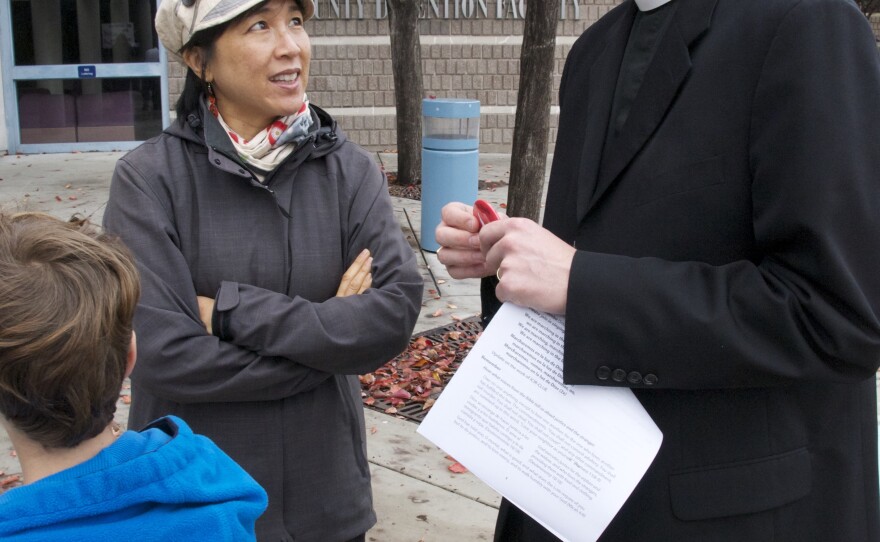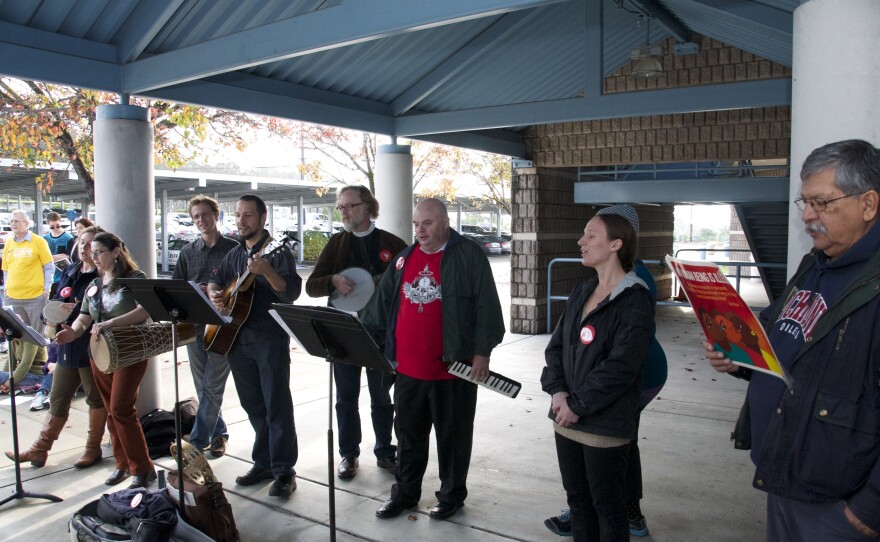Every month Alex Aldana stands in protest in front of the West County Detention Facility in Richmond. It’s a medium-security jail that holds men and women arrested for or convicted of crimes -- as well as undocumented immigrants. On the first Saturday of December, Aldana tells his story to about a hundred supporters, who are holding posters, noisemakers, and musical instruments.
“As somebody that is undocumented, I fully didn’t understand what it was like to be in detention, until recently,” he begins.
Aldana first came to the United States with his mother when he was eleven, and he’s lived here ever since. In December 2013, at age 26, he traveled to Mexico to see his dying grandmother. In early 2014, he tried to come back to the U.S. and asked for asylum.
“I came here, quote unquote, ‘the right way,’” he says. “I presented myself to the border, and I was handcuffed; I was actually chained from my feet to my waist to my neck, for the simple reason of asking for asylum.”
He was taken to a detention facility in San Diego. Like most immigrants in his situation, Aldana didn’t know how long he would be held or when he’d have a hearing; whether he’d be released or simply deported.
“For us that have been detained, just being in a little space in a white room, not knowing what’s going to happen to your case, not knowing if you’re going to see your family the next day, it’s nerve-breaking,” Aldana says.
Changing rules
From 2008 until late last year, federal Immigration and Customs Enforcement, or ICE, checked fingerprints from local police bookings against its immigration database, in a program known as Secure Communities. When they discovered that someone who’d been arrested was also undocumented, they would detain that person at a place like Richmond’s West County. Last November, the Department of Homeland Security declared a change in policy: ICE would detain only undocumented immigrants accused of certain crimes, such as espionage, gang activity and domestic violence. But they still check fingerprints, and immigrant advocates say people are still at risk of being detained.
Reverend Deborah Lee, Director of the Interfaith Coalition for Immigrant Rights, coordinates these monthly vigils for the immigrants inside. “[They] are in every way refugees, but they’re not being treated like refugees,” she says. “They are being criminalized.”
After the vigil, Alex Aldana stands in the sunshine near the jail entrance and talks about what life is like now that he’s out of detention. He was released on bail after nearly three months, and he has a lawyer and a case pending for asylum. But he still doesn’t feel secure.
“I was lucky to get a bond,” he says. But it was expensive. “Coming from a low-income family, it was really harsh. It destroyed our little economy that we had. And again, you can’t even work; once you’re released you have to wait six months to a year sometimes to get a work permit. So I have to move from place to place … having that trauma of being chased, or even being at risk of being deported again — it’s something that I live with every day.”
As of late February, 92 immigrants were being held at West County. ICE says on average they’ll be here one month, though Deborah Lee says some, like Alex Aldana, will be held longer. The Secure Communities program may have officially ended, she says, but she’s still cautious.
“We need to be very vigilant about the program they’re putting in its place, because it does not completely eliminate cooperation between local law enforcement and ICE,” she says.
Visiting hours
In late January, I go back to West County for visiting hours. Eight or nine people wait in the lobby as a sheriff’s deputy reads the visitors’ rules.
Coming for a visit is not easy. For starters, the official Contra Costa County website lists different visiting days from what’s posted here in the lobby. Visitors must arrive at least thirty minutes beforehand to register, and they’re faced with a long list of rules about what they can wear, and what they can bring inside.
Access isn’t easy for reporters, either. The Contra Costa Sheriff’s Department declined an interview and referred me to an ICE spokesperson, who also declined, though she did answer questions by email. None of the sheriff’s deputies at the facility were willing to talk on tape during my two visits, but I could record in the jail lobby. Many people I spoke with feared that their friends or relatives, arrested for minor violations, would be held longer because of their immigration status.
Fidel Sanchez is here to visit a friend, whom he says ICE agents picked up a week earlier in San Francisco’s Bayview neighborhood.
“Somebody reported he was working with no paper, and ICE was waiting for him in front of the house,” says Sanchez. “They caught him before he went to work.”
In a three-minute phone call from jail, his friend said he was worried about his family back in Honduras, where the new school year starts in February.
“They’re supposed to wait for money for to pay the school stuff, but it’s not possible,” Sanchez says. “But I make a garage sale the last week, I get some money, I sent to the family, to Honduras, his kid can go to school.”
Immigrants like Sanchez’s friend and Alex Aldana say that’s one of the hardest things about detention: the disruption of income and family life. President Obama’s recent executive order would offer temporary protection to about one-third of the undocumented immigrants currently in the U.S. But the protection is uneven. Alex Aldana’s mother would qualify, but Aldana himself would not. A federal judge put a halt on the executive order in mid-February, and the Obama Administration is appealing that decision.




